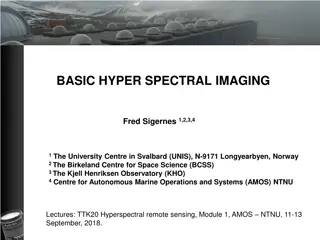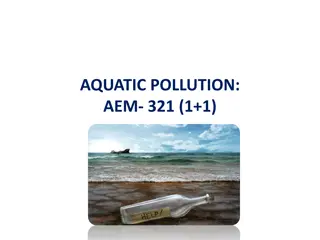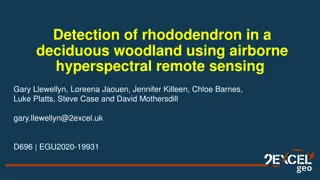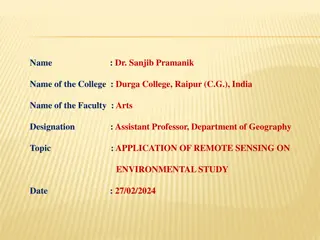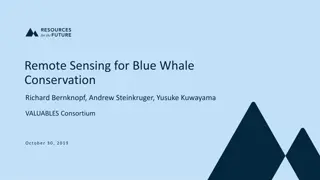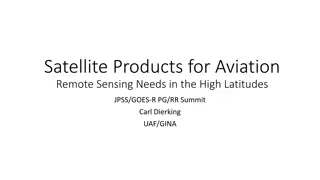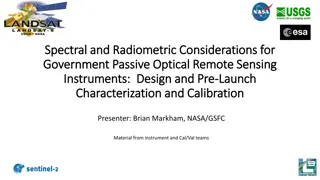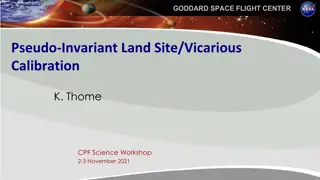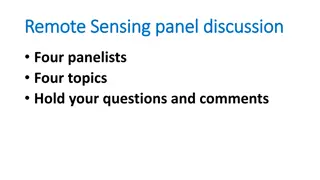Exploring Advances in Hyperspectral Remote Sensing Science for Aquatic Environments
This conference focuses on the latest developments in hyperspectral remote sensing technology for studying aquatic environments. With sessions covering topics like atmospheric correction, ocean color imagery, and water quality monitoring, experts discuss how hyperspectral data can address critical scientific questions in disciplines such as phytoplankton ecology, coral reef studies, and global ecological responses to climate change.
- Hyperspectral remote sensing
- Aquatic environments
- Scientific advancements
- Ocean ecology
- Environmental monitoring
Download Presentation

Please find below an Image/Link to download the presentation.
The content on the website is provided AS IS for your information and personal use only. It may not be sold, licensed, or shared on other websites without obtaining consent from the author. Download presentation by click this link. If you encounter any issues during the download, it is possible that the publisher has removed the file from their server.
E N D
Presentation Transcript
Splinter 7: Advances in Hyperspectral Remote Sensing Science Co-Chairs: Part I - Kevin Turpie (UMBC GSFC), Cecile Rousseaux (USRA NASA) Part II - Maria Tzortiou (CUNY), Emmanuel Boss (Univ of Maine) Part III - Michelle Gierach (NASA JPL), Sherry Palacios (BAERI ARC)
Splinter Agenda: Part I: Hyperspectral Remote Sensing Technology for Aquatic Environments 08:45-08:50 Introduction and overview Cecile Rousseaux (USRA, NASA GSFC) 08:50-09:10 Hyperspectral atmospheric correction Bo-Cai Gao (Naval Research Lab) 09:10-09:30 IOP and derived products from hyperspectral measurements. Steve Ackleson (Naval Research Lab) 09:30-09:45 Hyperspectral datasets for algorithm development Kevin Turpie (UMBC) Part II: Hyperspectral Science and Applications for Shelf and Open Ocean Processes 09:45-10:05 Hyperspectral ocean colour imagery and applications to studies of phytoplankton ecology Astrid Bracher (Alfred Wegener Institute) 10:05-10:25 Hyperspectral remote sensing and applications to studies of the oceanic carbon pump David Siegel (UCSB) 10:25-10:45 Benefits and challenges of applying hyperspectral ocean colour imagery to monitor and understand ecological global and synoptic response to climate change Mike Behrenfeld (Oregon State U.) 10:45-11:00 Coffee Break Part III: Hyperspectral Studies of Coastal and Inland Waters 11:00-11:20 Hyperspectral remote sensing and application to phytoplankton biodiversity Stewart Bernard (CSIR) 11:20-11:40 Coral reef colour: Remote and in-situ hyperspectral sensing of reef structure and function Eric Hochberg (BIOS) 11:40-12:00 Remote sensing of water quality: Can hyperspectral imagery improve public health? Clarissa Anderson (UCSC)
In situ and airborne sensor already deployed (e.g. AVIRIS, PRISM) HICO, first spaceborne instrument PACE: global hyperspectral ocean color radiometry for ocean biology and ecology and the carbon cycle (along with polarimetry?) There remains a lot of questions on the operational infrastructure and resources needed to support a mission Objective: to identify these challenges and the progress made towards resolution HyspIRI PRISM HICO
1) How will hyperspectral data help to address the driving science questions in your sub- discipline that will guide your community in the coming decade? Accurate separation of in-water constituents leads to more information to tackle science questions PFTs-Astrid Bracher, CORAL-Eric Hochberg HAB-Clarissa Anderson (Can we discriminate between taxa and physiological status including toxin production) Succession in colors , cyanobacteria bloom, iron stress, zooplankton ,birds,etc- Mike Behrenfeld Example of discrimination between phytoplankton diversity and size (Stewart Bernard) Better understanding of the drivers and effects of variable primary production across oceanic and aquatic systems, and the importance of resolving phytoplankton community structure, preferably at the submeso- and event scale [Stewart Bernard]
2) How does scale (e.g., spectral, spatial, and/or temporal) affect your ability to address these science questions? What is the smallest measurement scale needed to address your science? Scale depends highly on the topic of interest (1km, 500 m) Importance of Geostationary satellites in coastal areas Temporal resolution-combination of LEO and GEO (e.g. GEO-CAPE) 3) What are the common challenges across sub-disciplines in working with hyperspectral data? Data volume Processing/storage and distribution Downlink (transmission of data from the satellite) Engineering challenges: quality of radiometry & spatial/temporal aspects [Stewart Bernard] Calibration (pre-launch calibration in the UV, lunar calibration doesn t serve well for the Calibration of the specific detectors, solar diffuser panel if multiple detectors) Better understanding of signal variability and constraints, robust error handling needed [Stewart Bernard]
4) How do we coordinate and integrate common algorithm development efforts? List priorities-have a dialogue in the community Multi-stage (from experimental to standard) with peer-review process (with ATBD or equivalent) Distribution of data (measure, synthetic or algorithms) More international collaboration/comparison (need community platform) 5) Are there any observational or programmatic gaps across the planned hyperspectral missions? Need for convergence between satellite and models Atmospheric correction (NO2 absorption, solar irradiance curve, absorbing aerosols, etc-Bo-Cai Gao) Need for In situ data in a variety of water types (Kevin Turpie, Dave Siegel-PSD, PFT,etc, best practice + SeaBASS for case-II waters-Steven Ackleson, routine and well- constrained data -Stewart Bernard) Need bioArgo floats Need for centralization of algorithms and in situ database Geostationary satellite will enable regional observations of dynamic and complex coastal shelf process Modeling and optical community need to agree on parameters/units Lack of any follow-on plan after PACE
6) What other space-based measurements or modeled data, done in parallel to hyperspectral measurements, would you like to have to obtain more out of ocean color? Modeled data complementary to measurements can provide crucial information for SQ Linkages between data and models (assimilation, assessment, etc) Hydrodynamic/biogeochemical/particle models using the same bio-optical models to allow convergence at Lw level [Stewart Bernard] Lidar-> physiological status [Clarissa Anderson, Mike Behrenfeld] Ozone, NO2, SST, SSH Meteorological data (e.g. winds speed and direction, pressure, relative humidity)
Summary Still a lot of unknown on what we can derive from hyperspectral measurements And how we will achieve this on the engineer level But with a lot of international collaboration (data, algorithm, what s needed, etc) there is a world of opportunities







